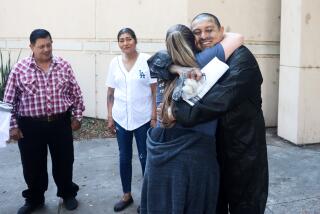Joint Research Explores Keys to Why Certain Children Survive Car Crashes
WASHINGTON — Each year, more than 1 million children are hapless passengers in car crashes, jolted by screeching brakes, shattering glass and crumpling metal.
But little hard information is available on why some get hurt while others walk away--data that could help engineers and parents reduce the leading cause of childhood deaths.
That may be about to change.
A meeting between a pediatrician with an engineering degree and an insurance company researcher has led to the most ambitious study ever of children in crashes.
The six-year partnership between State Farm Insurance Cos. and Children’s Hospital of Philadelphia will examine tens of thousands of accidents. It may help explain why, despite improved safety features in cars, passenger death rates for children have not declined as much as for adults.
Understanding Grows of Air Bag Safety
After little more than a year, initial data from the Partners for Child Passenger Safety project already has broadened understanding of air bags. Case studies showed that elementary school-age children wearing lap and shoulder belts in vehicles equipped with air bags survived with minor injuries in the same kinds of crashes in which air bags killed unbelted children.
Those findings are not a green light to put children in front of air bags in vehicles, experts emphasized, but they do suggest that air bags could be designed to be safe for all passengers.
Dr. Flaura Winston, the pediatrician-engineer who started the project, said that it goes far beyond air bags.
“Somewhere around 90 children have been killed by air bags. But in that same period some 10,000 have died in car crashes not related to air bags,” Winston said. “We didn’t want to ignore this really big public health issue.”
The researchers also want to learn more about side-impact crashes. Studies in Europe have shown that such crashes are particularly dangerous for children. While auto makers are introducing side air bags to protect adults in front seats, there is much uncertainty about how to improve the margin of safety for kids.
Finally, Winston is hoping the study will develop data that can lead to improvements in child seat designs.
Data Gathered Daily on Accident Specifics
The Partners project is the closest thing to a real-time surveillance network for child auto safety in the United States. Every day, 7,500 State Farm claims representatives in California, 14 other states and Washington, D.C., send reports on accident cases to doctors and engineers at Children’s Hospital via e-mail. (Policyholders are asked for permission before any data are shared.) In an average week it adds up to more than 1,000 crashes involving about 1,600 children.
State Farm is spending $14 million on the project, which also will include 15,000 detailed interviews with parents and special investigations of 600 selected crashes. John Werner, who as State Farm’s assistant research director is teamed with Winston, said that the company is interested in finding out about children who emerge from crashes--even serious ones--with little harm.
“Most of the studies based on hospital emergency room cases deal with a really limited number of serious cases,” said Werner. “We thought it would be appropriate to include all kinds of crashes and look at what happens when the kids are not injured.”
The company is already using information from the project to educate its policyholders on how best to protect their children.
Werner was introduced to Winston about five years ago, while on a trip to Philadelphia to meet with university researchers. Winston had done some of the earliest work describing cases in which air bags killed children. However, the initial reports from the Partners project provide the first in-depth study of cases in which children survived an air bag crash with little more than scrapes.
The research indicated that using lap and shoulder belts made a critical difference.
In one pair of cases, two 5-year-old girls were riding in the front seats of 1995 Ford Contour sedans equipped with passenger air bags. The cars were involved in comparable crashes of moderate severity.
“One child received fatal . . . spine and brain injuries, the other only facial abrasions,” the researchers reported. “The most striking difference between the crashes was [that] the fatally injured child was unrestrained and the child with minor injuries was wearing her three-point belt.”
Lap and shoulder belts work because they hold children back from an air bag in the critical fraction of a second when it is filling up with enough force to break a neck.
The findings come as the federal government is close to making final a major revision of safety requirements for air bags. It will call for technological improvements, such as air bags that can sense the presence of a child and turn themselves off. The National Highway Traffic Safety Administration, which has been drafting the requirements, had no comment on the Children’s Hospital study.
However, the auto industry is keenly interested. “There are probably tens of thousands of times in which an air bag has deployed with a child in the front seat,” said Barry Felrice, a DaimlerChrysler regulatory expert. “We certainly haven’t seen tens of thousands of deaths.”
Potential Exists for Making Devices Safer
Kristy Arbogast, a biomechanical engineer on the Partners project, said the cases show that “the potential exists to make a child-friendly air bag.”
“When that time comes, it’s going to be important to realize that most of the deaths that have occurred have been due to unrestrained children,” she added. “That fact hasn’t gotten out as much as the message that air bags are bad.”
Arbogast stressed that she would not put a child in front of an air bag in current cars. Computer simulations by researchers at Children’s Hospital concluded that even children who are belted can be harmed by today’s air bags in high-speed crashes.






